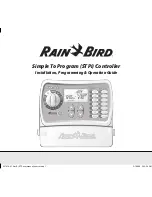
Binary symbols 0/1 from all three columns (Sensus Meter ID, Alarm Flag, RSSI) put together three-bit binary
number. Decimal form of this number can be used as ”smask” command parameter.
Required
”
mask” of message content can be entered by entering of mask decimal number (= number in ”Mask”
column) after ”smask” command. Example:
cfg#smask 3
Send mask changed to 3 :
SID, Alarm
mon#
As it is clear from the example, in the messages with mask number ”3” there will be transferred only ”SID” (meter
ID) and ”Alarm” (Sensus Alarm Flag) values, without RSSI value. This setting will determine message content as
it is described in detail in paragraph
”
The NB-K430 module data messages”. Values of watermeter counters are
always transferred, they cannot be removed from the message.
As NB-IoT services are typically charged per volume of transferred data, it is important to set appropriate message
structure, that transfers only data that are really useful. If, as an example, Sensus Alarm Flags cannot be decoded
in the superior remote reading system, transferring of this information has no sense.
3.1.6
Commands for setting of message broadcasting system
This group of commands enables setting of system for radio-broadcasting of the information messages. There are
following commands:
ekey
setting of encryption key (”.” - encryption disabled)
periode
setting of regular messages broadcasting period
server
setting of target server IP-address
sport
setting of target server port number
sreply
redirection of replies to target server
apn
setting of private network Access Point Name (APN)
sess
maximum session time
tconn
connection setup timeout
tz
setting of time zone (UTC + n)
time
real time (RTC) displaying/setting (hh:mm:ss)
date
real time (RTC) displaying/setting (RR.MM.DD)
The command
”
Encryption key”
is used for setting of the encryption key for an encryption of transmitted
messages by using of AES-128 key. The encryption key of 16 bytes length is entered by using of
”
ekey“
command,
followed by the string of 16 bytes that can be entered in a decimal or hexadecimal format (see examples).
An example of insertion of the encryption key in hexadecimal format:
cfg#ekey 0x1a 0x2b 0x3c 0x4d 0x5e 0x6f 0xa1 0xb2 0xc3 0xd4 0xe5 0xf6 0x77 0x88 0x99 0xaf
Setting encryption key : 1a 2b 3c 4d 5e 6f a1 b2 c3 d4 e5 f6 77 88 99 af
cfg#
An example of insertion of the encryption key in decimal format:
cfg#ekey42 53 159 188 255 138 241 202 136 21 98 147 235 15 145 136
Setting encyption key : 2a 35 9f bc ff 8a f1 ca 88 15 62 93 eb 0f 91 88
cfg#
If the encryption key is set to the module’s configuration, an information
”
Data will be encrypted by AES”
displays in the list of configuration parameters (see paragraph
Encryption can be switched off by setting of ”.” (dot) parameter after the
”
ekey“ command:
cfg#ekey.
Encyption disabling
cfg#
In this case an information
”
Data will be unencrypted”
appears in the list of configuration parameters
.
NB-K430
12
















































